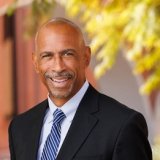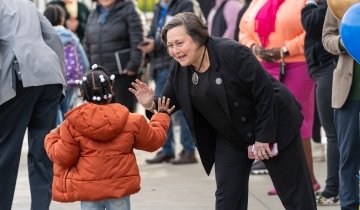Pedro A. Noguera’s appointment as the USC Rossier School of Education's new dean was among the first dean appointments made by USC President Carol L. Folt since she assumed her role in 2019. Shortly after Noguera’s term began, Folt interviewed him. In the interview below, the two swap roles, with Noguera asking the questions. Here, they discuss leading USC during a pandemic, the importance of keeping dialogue open and how her experiences as a community college transfer student shaped her perspective on college access.
The pandemic is having a far-reaching impact on society generally and education specifically. The focus has largely been about reopening, but how are you thinking about the possibilities that will be created as a result of the pandemic, particularly for higher education?
As a dean and as a president, you and I both want to make sure that all that we’re doing now has a positive effect today and is an enabler for ideas ahead.
Here are three examples. First, the pandemic is making us focus even more on disparities in educational access. It’s critical that we find a way to make sure people are not being left behind by the technological explosion that is happening in education. We can continue to build these fabulous online learning experiences, but we have to be deeply mindful that not all students may be able to access them. If schools don’t ensure students have access, we could see an increasing gap between haves and have-nots. At USC, we need to make it our mission to fight that gap in our own programs and help K–12 schools in our communities in that fight, as well.
Second, the pandemic is intensifying trends that are already happening—including high-octane technological and scientific innovation, and changes in how and where people work. People say 40 percent of the jobs of today are going to be technologically changed in just four years. This is our moment to prepare students so that they can leave USC not only ready to be part of this new workforce, but ready to help create it.
Third, the pandemic is allowing us to evaluate where learning takes place. I’m excited that we are creating universities that go with us in our pockets. We’re asking question such as, “What is telelearning going to look like?” and “How can we use telelearning to bring in and educate people from different backgrounds, bring in students that never thought they’d make it to a university?”
Before becoming a university president, you were a scientist, and I imagine you did work in the lab. How do you do collaborative work online?
I still think of myself as a scientist and still do some research. As a field biologist, I spent a lot of time in my waders, sampling streams and throwing nets. But, for every day I spent in the field, I spent maybe six months doing the chemical and data analysis with my team of collaborators—students, postdocs and other faculty. Scientists are learning how to do many things in new ways—even to collect data using remote sensing and databases. Scientists are very collaborative and have worked online for years. That, of course, is getting easier every year.
But teaching science online is difficult because so much of the learning comes from hands-on laboratory work. I’ve been so excited to hear that Dornsife is mailing out home laboratory packages to students. The good news is a lot of science begins before the high-tech and the hands-on experience. It involves the conception of the problem and the design of the experiments, and that type of collaboration can be done quite effectively online. Experiments don’t need to be high-tech to be deeply challenging. Residential education will be necessary, but you can do a lot before you get there.
"I’ve been so excited to hear that Dornsife is mailing out home laboratory packages to students. The good news is a lot of science begins before the high-tech and the hands-on experience.” —USC President Carol L. Folt
One of the features that distinguishes USC is its innovative approach to higher education. We also live in Los Angeles, and we’re surrounded by schools that are serving very low-income kids and are struggling. How do we make sure that USC, as an institution, is contributing to the educational life of the city?
I like to think that USC is a private university with a public heart. Our mission is deeply rooted in the collective good. We get the best faculty and students, not because they want to go into an ivory tower that doesn’t have responsibility to communities, but because they think by coming here, they may have more flexibility so they can act quickly and innovatively in communities. Rossier is a great example of one of our schools that has never separated itself from Los Angeles. It’s always been in partnership with L.A., with L.A. County and with Southern California.
We need to turn to leaders like you, and the programs that Rossier is already developing, and give you the help you need. That’s exactly what a great university will do if it truly wants to be an anchor for a major urban center like Los Angeles.
I’ve often wondered why it is that university towns don’t have the best public schools. I think it’s because there’s a separation, so figuring out how we engage the local community is really important.
Your question brings to mind the USC College Advising Corps, which I know is a big initiative at Rossier. The program takes talented graduates, trained by our staff, and places them as counselors in local schools that would otherwise have virtually no college counseling. The results are phenomenal. For example, when one of these advisers is brought in, schools that might have had 30 to 40 percent of their students applying for college can more than double their applications and help the students successfully apply for financial aid in the next year. These results tell you that every one of those kids wants to go to college. So, more of those programs and more programs like USC’s Neighborhood Academic Initiative are desperately needed.
There’s so much political polarization these days. I’ve written a book with a conservative writer on education, touching on all the controversies of the last several years, and we did it to demonstrate that we can disagree in a reasonable manner without degenerating to name-calling and attacking each other. I’m hoping that that spirit lives in the university. How do we keep dialogue open?
I honestly think you have to lead with heart and empathy. When you’re a president or a dean, everyone’s going to want you to denounce things. I don’t think our job is to denounce. Our job is to hold the line on important issues while always making sure that we create a space for reasoned debate. For this to work at a university, everyone has to embrace this mission and treat each other with respect when they are debating across different viewpoints.
When you arrived at USC last summer, seven universities were in the middle of an admissions scandal, and USC was one of the universities implicated. How do we ensure that we continue to keep the university accessible to students of the highest caliber, but from all backgrounds, and make sure that something like this is part of our past?
One of the most damaging things was the idea that only certain people get into top universities. We need to continue to demonstrate that that is not true at USC. To begin with, what does our student body look like? How do we distribute financial aid? What are we doing to make sure students can come? Are we truly need-blind? One of the first things I did was start the program that said if you come from a family with an annual income less than $80,000 a year, you get free tuition at USC. That program launched this semester.
"About one of every four transfer students who attend a private AAU-member university enrolled at USC. We need to keep pushing those programs and ourselves further, to get out into neighborhoods where kids may not be thinking they could ever come here and help them believe that USC could be a place for them, too.” —USC President Carol L. Folt
Today, two-thirds of USC undergraduates receive some form of financial aid. In 2019-2020, the university provided nearly $295 million in need-based grant funding from all available sources, and we expect to award financial aid to over 28,000 undergraduate and graduate students by the end of this academic year. Our need-based grants have increased by 38 percent over the last five years, far outpacing tuition increases. Overall, the university has one of the most generous financial aid pools in the country and is a nationally recognized leader in recruiting, enrolling and supporting low-income students.
In addition, the USC transfer program is one of the strongest ways we bring in students from all backgrounds. About one of every four transfer students who attend a private Association of American University-member university enrolled at USC. We need to keep pushing those programs and ourselves further, to get out into neighborhoods where kids may not be thinking they could ever come here and help them believe that USC could be a place for them, too.
I heard you say you were a community college transfer.
I was. I dropped out of Ohio State. I worked in a bank and then as a waitress on the pier in Santa Barbara. I put myself through school at Santa Barbara City College and then at UC Santa Barbara. My own experience taught me that students who come in from less traditional backgrounds bring a wealth of experience and knowledge, and that’s one of the reasons I try so hard to open those doors.





